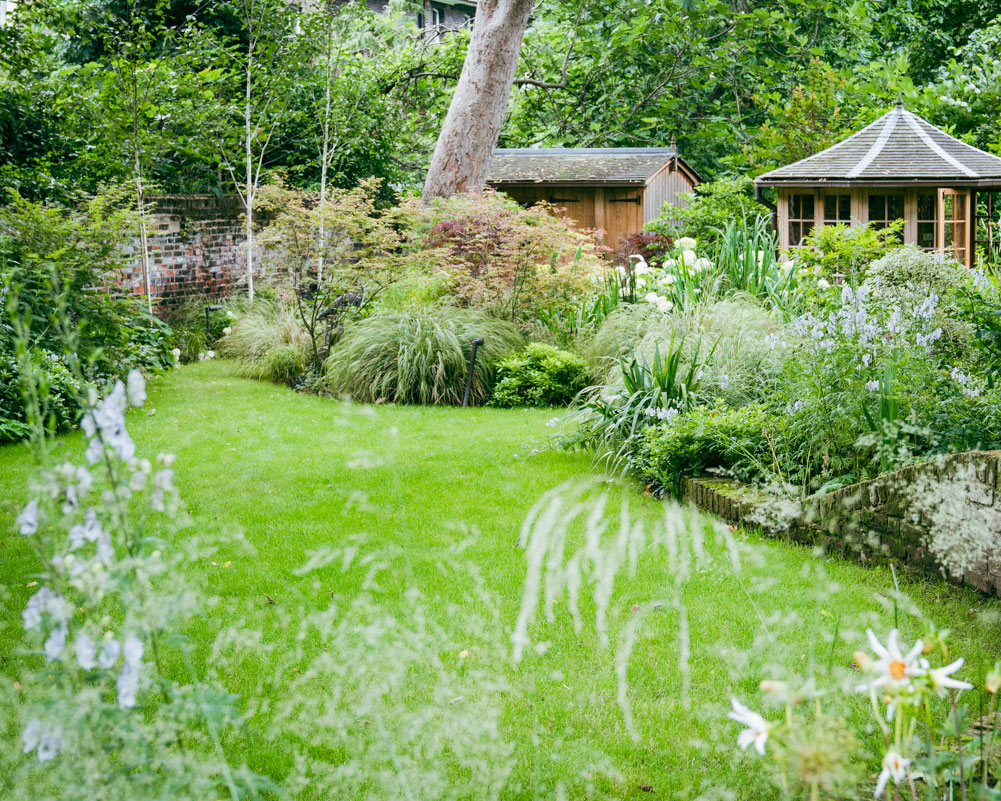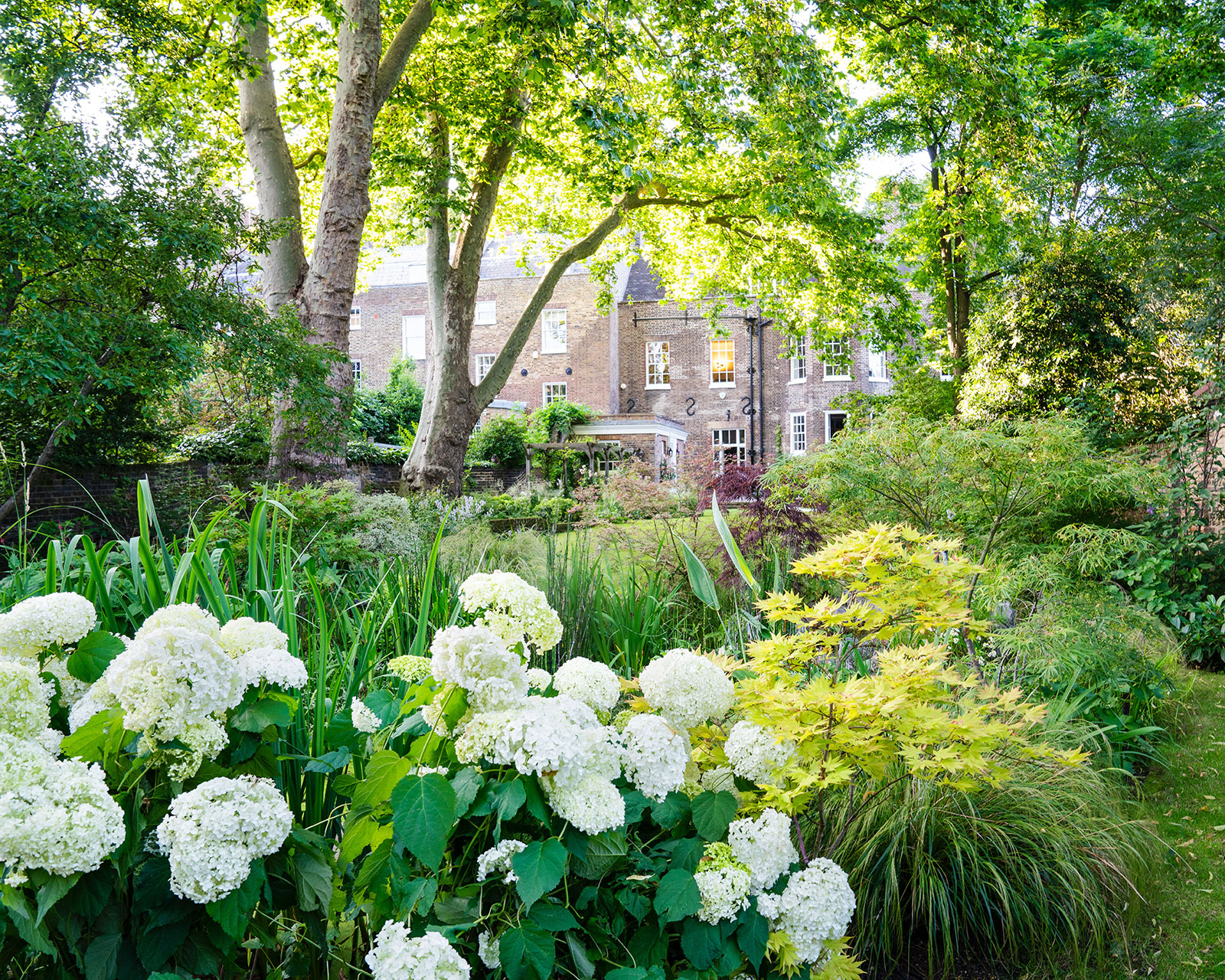5 city garden design lessons we've learnt from this elegant urban plot
Among the design features of this peaceful, urban garden oasis are curves and contours, wildlife pond and color and texture from shrubs and small trees


The design ideas used in the creation of this London garden result in a calm and relaxing oasis in an urban environment, and give the impression the plot has evolved naturally over many years.
It now has a sense of belonging to the stunning Georgian house and tree-lined gardens that surround it.
Large garden borders in scale with the house, soft lines, subtly separated garden rooms, wildlife pond, and structure from shrubs and trees are among the garden ideas that have resulted in such a beautiful space.
'There was nothing in the garden before – it was all laid to lawn, with enormous plane trees and shallow, neglected borders,' explains garden designer Jo Thompson.
'The owners wanted to create a garden which sat well in its location; a romantic, welcoming, family space to be enjoyed by all. It has the look of gentle intervention rather than a heavy stamp of design,' Jo adds.
Nodding to the history of the house, the space incorporates elements of Georgian garden design.
Jo shares her design ideas for creating this elegant and peaceful city garden.
Design expertise in your inbox – from inspiring decorating ideas and beautiful celebrity homes to practical gardening advice and shopping round-ups.
1. Use soft lines to add character

Curves and contours help to give a more natural look.
'The soft lines of the design add to the character and romance of the space. Curving flower bed ideas lead you through the garden notionally separating areas without obvious division,' explains Jo.
The curves open and contract at key points to create vistas and frame views. Snaking grass garden path ideas through the generous garden beds help create different areas without obvious boundaries.
'There is a sense of gentle undulations as you move through the space, and also a little bit of height added in places,' Jo adds.
2. Include a wildlife pond for added interest
A garden pond enhances the biodiversity in the garden.
This is among a number of wildlife garden ideas that will support birds, insects and other visiting animals, which in turn will help pollinate and maintain the natural ecosystem of the garden.
'The pond is nestled into its location, surrounded by a range of shrubs to give it a sense of permanency and place, so that it feels as if it should be there. It is planted with a soft palette, and stepping stones create a little bit of mystery and magic,' explains Jo.
Water feature ideas were a hallmark of Georgian garden design, so it also fits with the heritage of the property.
3. Create structure with shrubs and small trees

Evergreen shrubs and small trees, such as hydrangeas, acers and magnolias abound, providing texture and form, the colors softly merging into each other through the seasons.
'An underpinning of elegance with seemingly relaxed abandon underpins the planting style, which is actually carefully thought through,' explains Jo.
Ease of maintenance is key is key to this style, so it is important to look after the plants and learn how to prune hydrangeas or take care of Japanese maple trees if you include similar shrubs or trees in your garden.
4. Build garden walls to add to the sense of privacy

The original garden walls were restored, and new garden wall ideas added, to create this secret walled garden in the heart of Georgian London.
'A kitchen garden is around one corner, with brick paths and espaliered fruit trees adorning walls; a functional, charming space which is hidden from the rest of the garden,' says Jo.
A solid gate in the back wall suggests that the journey continues, and adds to this feel of a secret garden within walls.
If you can't build walls, instead you can use trees for privacy and screening in a backyard, particularly useful in urban, overlooked spaces.
5. Separate areas and add height with a pergola

'An oak pergola adds a subtle sense of division without using a solid boundary, and creates a garden space for the guest suite sitting to one side of the terrace,' explains Jo.
The oak pergola suits the more natural aesthetic in this traditional setting. It is planted with some of the best climbing plants, roses and clematis, carefully selected to give color through the season. These include alpina to viticella clematis, and roses including ‘Madame Alfred Carrière’, ‘Albertine’, and Rosa banksiae var. banksiae.
There are many pergola ideas that can help provide structure to a backyard or delineate spaces.
The result of all of these subtle and cleaver design ideas is a timeless garden that perfectly complements the elegant Georgian home.
Rachel is senior content editor, and writes gardening content for homesandgardens.com, Homes & Gardens magazine, and its sister titles Period Living Magazine and Country Homes & Interiors. She has written for lifestyle magazines for many years, with a particular focus on gardening, historic houses and arts and crafts, but started out her journalism career in BBC radio, where she enjoyed reporting on and writing programme scripts for all manner of stories. Rachel then moved into regional lifestyle magazines, where the topics she wrote about, and people she interviewed, were as varied and eclectic as they were on radio. Always harboring a passion for homes and gardens, she jumped at the opportunity to work on The English Home and The English Garden magazines for a number of years, before joining the Period Living team.
